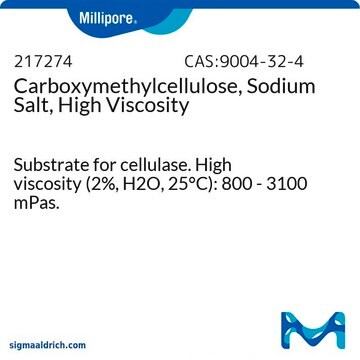C5013
Carboxymethylcellulose sodium salt
High viscosity
Sinónimos:
Sodium carboxymethylcellulose
About This Item
Productos recomendados
biological source
wood (pulp)
form
powder
color
light yellow
useful pH range
(20 °C, 10 g/L, 68 °F neutral)
viscosity
1500-3000 cP, 1 % in H2O(25 °C)(lit.)
mp
> 300.05 °C ((> 572.09 °F ))
solubility
H2O: 10 mg/mL
cation traces
Na: 6.5-9.5%
storage temp.
room temp
InChI
1S/C6H12O6.C2H4O2.Na/c7-1-3(9)5(11)6(12)4(10)2-8;1-2(3)4;/h1,3-6,8-12H,2H2;1H3,(H,3,4);
InChI key
DPXJVFZANSGRMM-UHFFFAOYSA-N
¿Está buscando productos similares? Visita Guía de comparación de productos
General description
Application
Preparation Note
Other Notes
Storage Class
11 - Combustible Solids
wgk_germany
WGK 1
flash_point_f
Not applicable
flash_point_c
Not applicable
ppe
Eyeshields, Gloves, type N95 (US)
Certificados de análisis (COA)
Busque Certificados de análisis (COA) introduciendo el número de lote del producto. Los números de lote se encuentran en la etiqueta del producto después de las palabras «Lot» o «Batch»
¿Ya tiene este producto?
Encuentre la documentación para los productos que ha comprado recientemente en la Biblioteca de documentos.
Los clientes también vieron
Nuestro equipo de científicos tiene experiencia en todas las áreas de investigación: Ciencias de la vida, Ciencia de los materiales, Síntesis química, Cromatografía, Analítica y muchas otras.
Póngase en contacto con el Servicio técnico

